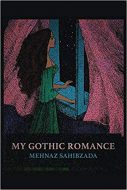 Mehnaz Sahibzada
Mehnaz Sahibzada
My Gothic Romance
Finishing Line Press
Reviewer: Ann Wehrman
In My Gothic Romance, Mehnaz Sahibzada explores perceptions of personal experiences and relationships through confessional, lyrical, and narrative poems. The 2019 collection is structured in two parts, “Dark” (twenty-eight poems) and “Light” (thirty-five poems). True to life, the poems divert subtly from their assigned categories in style and content, and that variegation of dark and light enhances the collection’s grounding in metaphysical realism.
In “Recluse,” from Part 1, “Dark,” Sahibzada paints a spooky emotional climate using words such as “sleeping alone,” “anxious,” and “stalked”:
… Don’t
tell me that sleeping alone doesn’t
make you anxious. Hollow sounds
crane my throat. I’ve lived alone since
childhood in this quaking house.
You have been here too. The door
a paperweight at 3am. The moon
so close, the mind feels stalked.
Sahibzada’s clear diction and emotive style burrow beneath her reader’s skin, skillfully creating a jittery, nerves-on-edge feeling that most readers who live alone, whether or not recluses, surely experience at times.
In “My Adventures as a Social Poet,” published in 1947 in Phylon (Vol. VIII, No.3), Harlem Renaissance poet Langston Hughes confides:
Poets who write mostly about love, roses and moonlight, sunsets and snow, must lead a very quiet life. Seldom, I imagine, does their poetry get them into difficulties. Beauty and lyricism are really related to another world, to ivory towers, to your head in the clouds, feet floating off the earth. Unfortunately, having been born poor – and also colored – in Missouri, I was stuck in the mud from the beginning.
My Gothic Romance might also get Sahibzada “into difficulties,” due to her forthright style, refusal to self-censor, and description of the emotional and physical pain that she both endures and causes as part of passionate love. In “Muse Noir,” she writes,
Every time I write, I sense his hand sliding
up my thigh. Blackening each metaphor, he hammers
my good-girl past until it shatters like a glass mug.
I can’t shrug him away. One night in Lahore
when I was fifteen, he climbed beside me in bed,
fastened a palm around my wrist. It was the only
time I saw his face, the square brown chin
and espresso-stained grin, the cunning smile that
colonized my head. I said, When I get back
to California, I’ll grind you up like a bean. But
he just waved a palm-sized cross and proposed.
I said yes, of course …
Speaking the truth takes courage, to first face the truth and then to risk stating it, both actions requiring internal struggle and commitment. When speaking truth about relationships, one may also incur repercussions, from losing those whom one thought were friends and lovers to encountering a response of aggression against oneself. For women, speaking truth all too often results in violence, from a slap or punch at home to the horrific ways in which women are demeaned, violated, and killed all over the world, even in the 21st century. It’s also no secret that speaking frankly of one’s passions, particularly when they exceed the finely drawn lines of social expectation, can invite censure and social condemnation.
Ideally, all communications should express the truth as best as their speakers perceive it. In contrast, humanity has a tradition of avoiding or denying the truth, of clinging to fallacies, and of propagating falsehood through lies, deception, and doublespeak. In this world, the difficulty involved in comprehending truth and then the courage involved in expressing it render speaking truth a rare and valuable gem, one that makes Sahibzada’s poems gleam like emeralds in candlelight.
In “Vulnerable,” the first poem of Part 2, “Light,” Sahibzada summarizes her intent:
I want to
show you
the places
under my skin
where I
was taught
to hold love close.
The reader is invited to speculate what the “places under my skin” are; the nouns suggestive of bruises, injections, broken bones, and organs (heart, womb). Rather than stating specifics, the poet asks one to guess, to ponder, and by doing so, the reader might remember his or her own pain, experienced and accepted in relationships, both as an adult and in childhood, such as “love” expressed through casual violence, corporal punishment, or even molestation – all common, tragically. However, one must pause and remember that Sahibzada features this poem at the beginning of the “Light” section of her collection. The speaker also states that she “hold[s] love close” in these “places under [her] skin”; instead of relics of pain endured, they are pockets of strength. Sahibzada moves her focus toward the light, as morning naturally returns, even sometimes overcast, after the darkest night. In the prose poem “Demon,” she writes,
You won’t give in to lethargy. You place a dozen carnations in a vase. Fold the laundry in the bedroom. Thinking about the person you once were, you shudder at the clownish desperation. When you watch horror films, you shudder at the sight of blood. A psychic once told you, stay calm, my dear. You’re surrounded by orbs of light. Sometimes, you can feel a demon pressing against your skull, but there’s also this white music.
In the end, each person must choose to act, and every action enhances light or darkness. One’s thoughts and actions inherently contain this element of choice, and that is part of what makes people both human and divine. The poems in My Gothic Romance chronicle and unflinchingly reflect upon choices, results, and the opportunity to choose anew.

